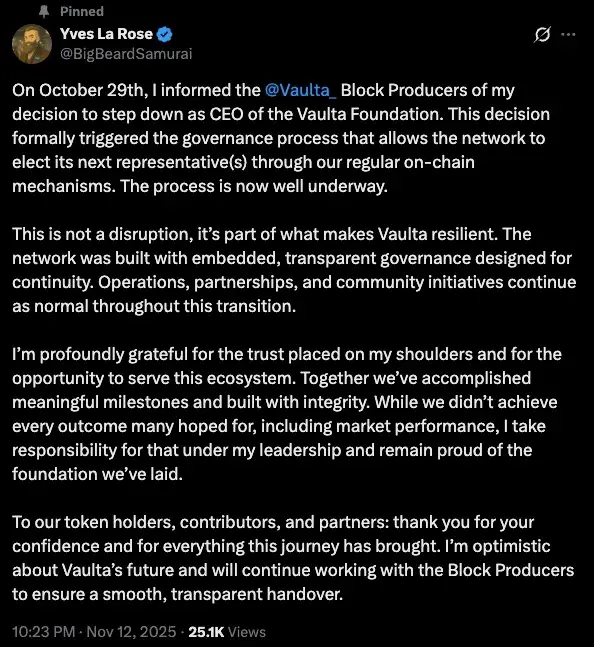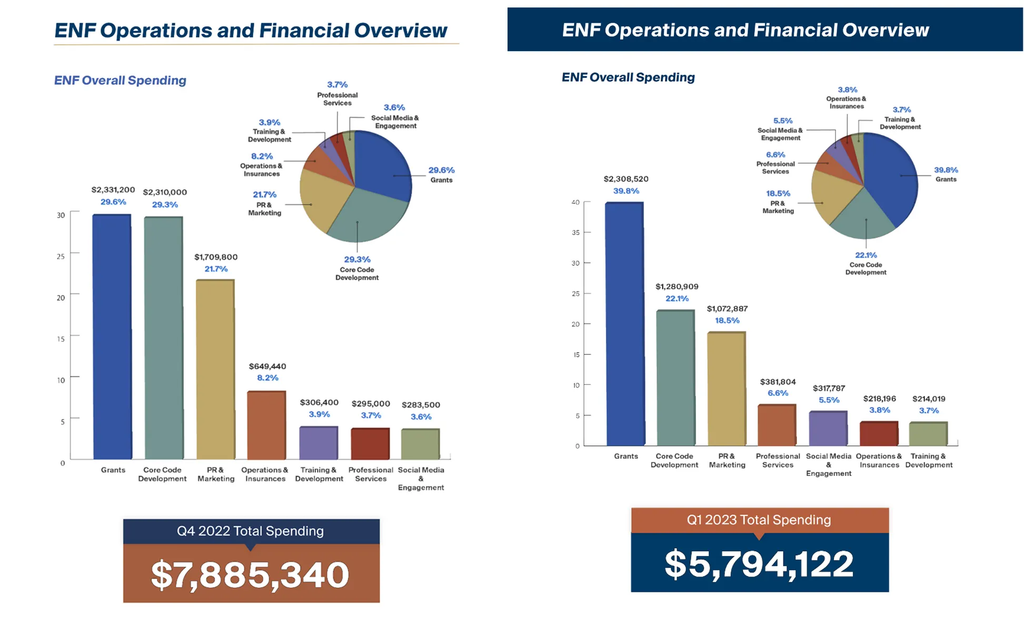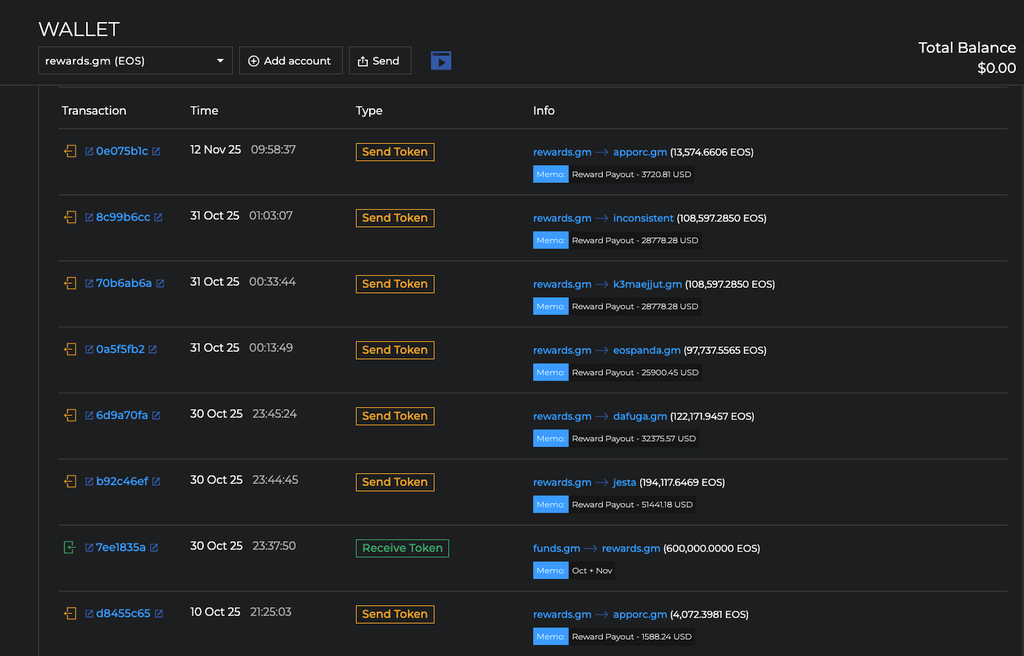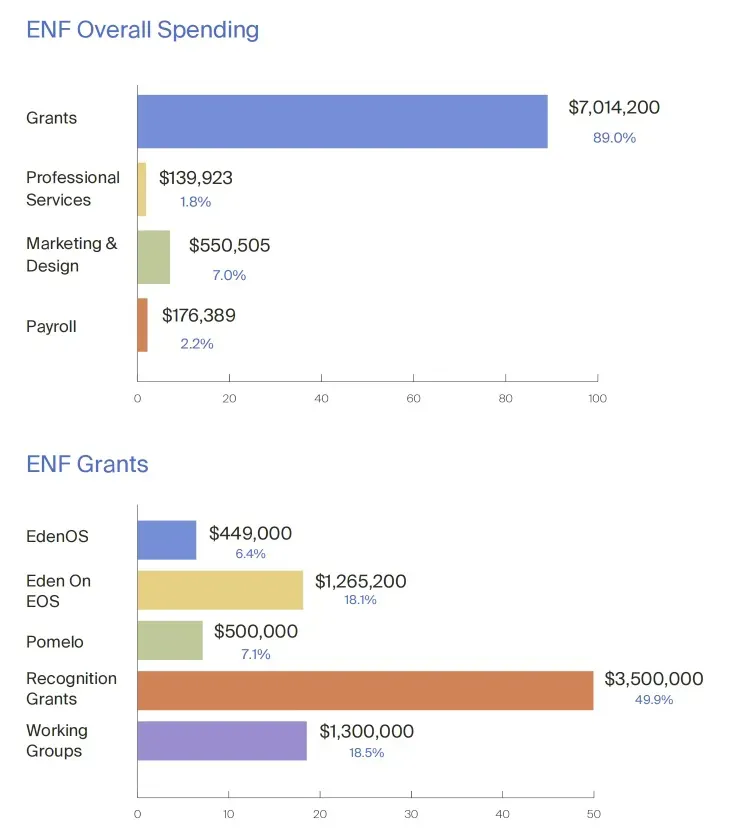Original Title: Vaulta Foundation's "Eating the Last Resort" Record: Plummeting Coin Prices, Disappearing Audits, and Complete Collapse of Community Trust
Original Author: MMK (@mmk_btc), Vaulta Community Member
Original Editor: Rhythm Little Worker, Rhythm BlockBeats
Editor's Note: Many people know about EOS, the early public chain that raised $4.2 billion seven years ago and was regarded as one of the earliest "Ethereum killers." However, few are aware that after BM was ousted from EOS, the parent company Block.one took the funds raised and shifted its focus to building the IPO trading platform Bullish. The remaining EOS was taken over by the EOS Network Foundation, led by CEO Yves La Rose, who is referred to as "Big Beard" by the community due to his thick beard. Subsequently, under Big Beard's leadership, EOS was renamed Vaulta, shifting towards Web3 banking services, and the EOS Network Foundation was also renamed the Vaulta Foundation. Recently, Big Beard's sudden departure has caused dissatisfaction within the community and has led to accusations regarding his past actions.
The Vaulta Foundation (formerly the EOS Network Foundation) is experiencing an unprecedented collapse of trust: burning tens of millions of dollars over four years while the coin price continues to hit new lows; projects failing one after another, with financial records going from public to non-existent; management resigning "gracefully" while failing to hand over authority… This article will reveal the various mysteries of Vaulta and tell a story of "eating the last resort."
Yves Resigns: Graceful Exit or Behind-the-Scenes "Shadow Governance"?
On November 12, 2025, Yves La Rose, the former CEO of the Vaulta Foundation (formerly the EOS Network Foundation, hereinafter referred to as VF), suddenly announced his resignation on the X platform, stating that he had notified the 21 block producers of the network on October 29 that he would voluntarily step down and that new representatives would be elected through on-chain governance. The statement was dignified, filled with "gratitude" and "vision," but the community was shocked to discover a few weeks later that the core multi-signature account of Vaulta was still under Yves's control, with no handover taking place.

Yves's personal resignation statement
Moreover, after his resignation, Yves secretly pushed for Aaron Cox, the founder of Greymass, to take over his position. The first thing Aaron did upon being thrust into the spotlight was to initiate a massive proposal of 10 million $A (EOS) to continue funding the core development budget. This move sparked widespread skepticism in the community: it was essentially a "life extension" using a proxy, diverting remaining public funds.
Charge One: Lavish Spending, Marketing Expenditures Become a Mystery
Since VF was established in 2021, ecological development has not accelerated over time.
On the contrary, the community has witnessed a disturbing trend: the budget has expanded year by year, while results have diminished year by year.
Under the guise of "ecological revitalization," VF launched a market expansion plan in 2022-2023. VF did recruit an excellent marketing team, and they did put in efforts in brand operations and international events.
But the key question is—what have these extravagant investments actually brought?
According to nine disclosed quarterly reports, marketing-related expenditures (PR & Marketing) alone reached: $1,709,800 in Q4 2022; and another $1,072,887 in Q1 2023.

In just six months, nearly $2.8 million was spent on brand promotion and public relations activities. However, the only results the community could see were: the number of conference attendances, images and reports; Twitter follower growth; 2000 days without downtime; EVM performance stress tests;
These data points are not without meaning, but they resemble PR slides rather than a true reflection of the ecological state. Developer growth? Absent. Daily on-chain activity? Not disclosed. TVL? Almost nonexistent. Why does spending more lead to a lower community perception? When all reports only discuss "highlights" without addressing "results," transparency naturally slips into a black box.
Charge Two: Immediate Payouts, Ongoing Controversy Over Greymass's $5 Million Budget
In June 2024, VF allocated 15 million $A (EOS) to establish a "middleware special fund," with the first batch of 5 million $A (EOS) allocated to the Greymass team, while the remaining 10 million is still in the eosio.mware account.
On-chain data shows: funds were transferred from the foundation's eosio.mware account to a newly established account by Greymass, uxuiuxuiuxui; subsequently, this wallet transferred funds monthly to http://funds.gm, with notes like "Operation + USD/CAD price," resembling "salary payments"; then, http://funds.gm transferred to http://rewards.gm, ultimately distributing to several accounts such as jesta, inconsistent, http://apporc.gm, etc., with transfer records annotated as "Reward Payout + USD amount"; most salary accounts quickly transferred their funds to exchanges like Kraken or Coinbase for cashing out.

On-chain transfer records from rewards.gm (data source)
Note: The "middleware" built by Greymass refers to infrastructure tools that simplify account creation and interaction processes.
Although the Greymass team released several development updates at the beginning of the funding, there have been almost no technical achievements or interim summaries published in the past year. In particular, Greymass's middleware tools still face numerous technical issues regarding compatibility and stability, and have not been widely adopted by mainstream developers.
The community's focus of skepticism lies in whether the 5 million $A (EOS) involved duplicate salaries, payments to unidentified accounts, and other opaque behaviors? Was the fund allocation closely aligned with Aaron's appointment, raising suspicions of "self-approved budgets"? Does the salary distribution structure lack third-party oversight? We do not deny that Greymass has contributed to ecological development, nor do we deny Aaron's early technical reputation. But were they misled by the new policies? Did they deviate from their original development intentions after losing oversight?
These questions remain unresolved.
What can be confirmed is that the silence and low output of the "Greymass $5 Million Project" have made it difficult for them to respond to the external trust crisis, further exacerbating the community's doubts about the rationality of the foundation's fund usage.
Charge Three: Plummeting Coin Prices, Foundation's "Silence," Responsibility Becomes a Blind Spot
If technical achievements can be debated and marketing effects quantified, then token prices are the most honest indicators.
This year, $A (EOS) has plummeted, reaching a low of $0.21—this is a dangerous signal that would trigger a red alert for any ecosystem. However, as the community continued to inquire, the foundation's response remained: "The coin price is not within the foundation's responsibilities."
This statement itself is irrefutable.
Technical organizations are not obligated to manipulate the market. But the contradiction lies in—when all ecological indicators are declining and community confidence is collapsing, the foundation has not engaged in any discussions about "stabilizing expectations" or "market protection mechanisms."
What followed were even more unsettling actions: the foundation announced its "dissolution," with no roadmap and no handover plan.
The community's question is not whether the foundation should be responsible for the coin price, but rather: at a critical moment when the ecosystem is in a trust crisis, why choose to withdraw: is it due to inability, disinterest, or are there issues that are inconvenient to face? Responsibility has vanished in this plunge.
Charge Four: From Weekly Updates to Complete Silence, Transparency Disappears Quietly
When VF was first established, transparency was once its biggest selling point.
2021: Weekly updates (Everything EOS Weekly Report), providing real-time progress reports to the community;
2022: Monthly reports (Monthly Yield Report), with slight lapses for a few months, but still acceptable;
2023: Quarterly reports (ENF Quarterly report)
2024: Silence… …
2025: Silence… …

From the disclosed report data, VF's highest expenditure was in Q4 2022, reaching $7,885,340; thereafter, expenditures gradually declined each quarter.
However, these reports often only disclose total amounts, lacking detailed classifications and specifics, making it difficult for outsiders to determine the direction of funds, and the community has long harbored doubts about the massive expenditures and lack of information transparency.
The reports frequently mention plans like Grant Framework and Pomelo, but they "stalled" in 2023; meanwhile, the promised fund management for specific projects in the white paper has not seen detailed execution or public settlement, and the whereabouts of funds after being allocated to exchanges remain a mystery.
This breakdown in transparency and years of extravagance have ultimately led to a collapse in community confidence.
From intensive disclosures to gradually sparse updates, and now to complete silence, the disappearance of transparency has almost perfectly synchronized with the decline in ecological enthusiasm.
More notably, since Q1 2024, no financial reports have been released. No financial audits, no budget distributions, no project lists, no unsettled allocations.
The community is forced to accept the fact that the foundation's operations have shifted from "high-frequency transparency" to "complete black box."
At the same time, several high-profile cooperative projects that VF once promoted have mostly stalled at the "communication stage," lacking actual implementation. The previously promised "transparent operations" have ultimately devolved into a silent cliff.
Charge Five: Arbitrary Allocations, Grants Become a "Black Hole," No One Knows Where the Money Went
Looking back at the foundation's early days, VF did attempt to rebuild the Vaulta (EOS) ecosystem through various funding programs, including Grant Framework, Recognition Grants, and a public funding pool used in conjunction with Pomelo.
During that phase, the speed and scale of fund disbursement were rapid, aiming to "stop the bleeding quickly."
We cannot deny that it did play a role in boosting morale in the early stages.

Here is a supplementary explanation regarding Grants: VF's funding is divided into publicly solicited "Grant Framework" (milestone-based funding), aimed at individuals, teams, or companies, primarily for technical projects; Recognition Grants (awards given to projects) and distribution to ecological projects through public funding channels like Pomelo. This means that the funding can be used for both profit-oriented projects and public goods/charity projects.
For example—in the first report of Q4 2021, VF allocated in one go:
- $3.5 million in Recognition Grants (averaging $100,000 per project);
- $1.3 million to fund five technical working groups to write white papers;
- $1.265 million to support the community self-governing organization EdenOnEOS;
- $500,000 as the funding pool for the first season of Pomelo;
However, the problem is—that was also the only quarter in the next four years where VF fully disclosed the recipients of the grants.
From Q4 2021 to Q4 2023, although Grants consistently accounted for the largest portion of quarterly expenditures (in some quarters, even 40% to 60% of total expenditures), the reports no longer disclosed specific grant recipients; did not publish the actual amounts received by each project; did not reveal project acceptance statuses; did not mention details of fund usage; and did not clarify whether projects delivered results according to milestones.
In other words, the numbers are still there, but the information has disappeared.
Only the first quarterly report disclosed the flow of funds for each project. In the subsequent eight reports, while Grants' expenditure remained the "largest portion," it no longer specified the benefiting projects or outcomes.
How much money was spent is visible, but where the money went remains unknown forever.
Did the funding truly promote the ecosystem? Was the money used effectively? Were the projects completed? Why does the foundation never disclose more information?
This inevitably raises doubts: Did the foundation, from the very beginning, use the banner of "ecological funding" to scatter money widely? Externally, it appears to buy off the community and win hearts, while internally it hoards inflationary funds and reserves, lacking results and oversight.
VF's matching pool funds exceed ten million dollars, but most projects have extremely sparse updates, even disappearing after receiving funds.
The End of an Era
The Vaulta Foundation once promised governance reform with a stance of "transparency and community-driven," but over the past four years, it has gradually moved towards closure and corruption.
From Yves's dignified resignation without handing over power, to the $5 million middleware funding with no accountability, from millions spent on quarterly marketing with no effect, to complete silence after ecological funding—this is not a failure of "decentralized governance," but a victory of "centralized plunder."
This lengthy article serves as a list of charges and a warning document.
The collapse of Vaulta is not just a tragedy for EOS, but also a microcosm of the trampling of Web3 ideals.
免责声明:本文章仅代表作者个人观点,不代表本平台的立场和观点。本文章仅供信息分享,不构成对任何人的任何投资建议。用户与作者之间的任何争议,与本平台无关。如网页中刊载的文章或图片涉及侵权,请提供相关的权利证明和身份证明发送邮件到support@aicoin.com,本平台相关工作人员将会进行核查。




